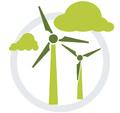Wind Energy

Overview
Winds are a naturally-occurring resource due to the Earth's rotation and the interaction of the uneven heating of the atmosphere with the uneven surface of the planet. The power of the wind can be harnessed through the use of wind turbines and generators to create electricity. Wind power exists in a number of scales: wind farms, community-scale installations, customer-sited projects, and household installations.
Benefits: Wind power provides an electrical resource without the harmful emissions associated with conventional electricity-generation sources. Due to the scale of some wind turbine installations, it is more feasible to manufacture turbines locally/regionally which has a direct economic benefit.
Concerns: Wind turbines can range in size with some as tall as 400 feet. As an intermittent source similar to solar, wind rates vary but are typically best sited on ridgelines and near the ocean (both of which are also considered typical scenic elements). Wind turbines can also impact wildlife such as birds and bats.
(Information provided by the U.S. Environmental Protection Agency)
Projects
Wind Turbine Generator Feasibility Study:
The Renewable Energy Committee worked with Meridian Associates to evaluate the potential for siting a wind turbine at the middle school (the best of three locations identified in 2008 by the UMass Renewable Energy Research Laboratory). The feasibility study was paid for by a $75,000 grant from the Massachusetts Clean Energy Center.
March 14, 2008 - Siting Considerations for a Wind Turbine by the UMass Renewable Energy Research Laboratory
June 1, 2011 - Wind Turbine Generator Feasibility Study - DRAFT
Appx. A - Triton SODAR Specifications
Appx. B - Triton Performance Study
Appx. C - WindPRO METEO Results
Appx. D - WindPRO Visual Results
Appx. E - Wind Turbine Noise Study
Appx. F - Site Plan
Appx. G - Electronic Communications Facilities
Appx. H - Energy Use Records
Appx. I - State Model Wind Ordinance
Appx. J - Federal Aviation Admin. Determination
Appx. K - Turbine Candidate Specifications
Appx. L - WindPRO SHADOW Results
Appx. M - P50 & P90 Turbine Productions
Appx. N - Financial Pro-forma
September 28, 2011 - Letter to the Editor from the Renewable Energy Committee
In the News
- January 6, 2012 - Swampscott Reporter - "Swampscott Middle School Wind Turbine Proposal Rejected"
